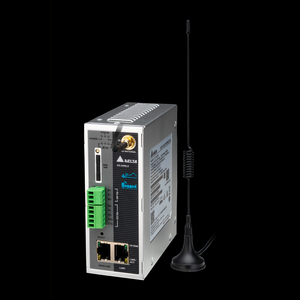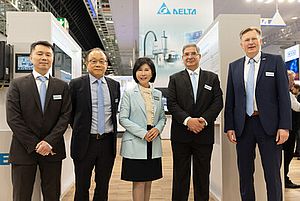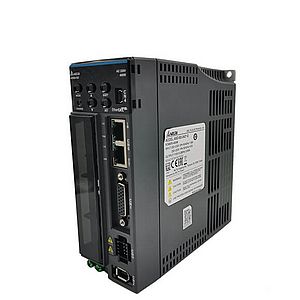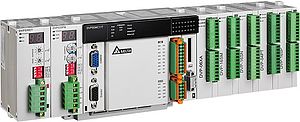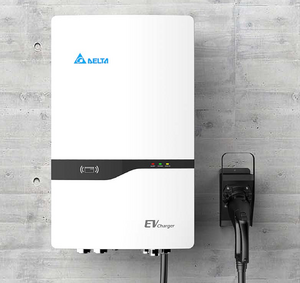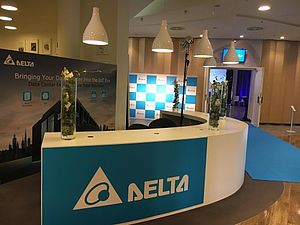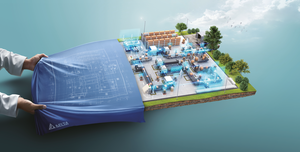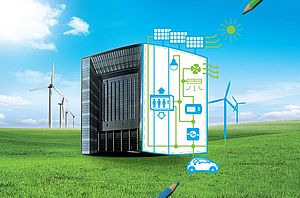IEN Europe: Can you please briefly introduce our readers to the new D-Bot series, which was showcased for the first time at the Hannover Messe? What are the highlights?
Mayer-Rosa: The new D-Bot series is our first cobot family. We have developed six different models, each of which has six axes and weighs between 26 and 85 kg. Depending on the model, payloads of 6 to 30 kg are moved at a speed of up to 200° per second, with a range of 800 to 1800 mm. This allows us to achieve a precision and repeatability of ±0.02 mm and furthermore, the integration of 24-bit encoders ensures a consistent performance. With this D-Bot series, we are introducing the next stage in the development of collaborative robotics, adding an important building block to our automation portfolio.
But that's not all. Other highlights include the fact that the D-Bots come with a wide range of functionalities such as Pick & Place, Palletizing, Machine Tending and Welding as 'ready-to-use' apps. In addition, no special programming knowledge is required – thanks to 'Plug & Play', the motion sequences can be specified, and the command execution described in no time at all. Another advantage is the high level of flexibility regarding the supported interfaces: EtherCAT, CAN Bus, IO Link and Modbus are supported – as is the manufacturer-independent Codesys development environment, which we use to maximize the efficiency of the cobots while ensuring maximum variability. Teaching is also simple via drag & drop or via Python, ROS 1 or C++.
IEN Europe: How do you see the new product series in relation to the existing Delta Robotics portfolio?
Mayer-Rosa: With the new D-Bot series, we are not only expanding our portfolio of SCARA robots and classic industrial robots, we are also expanding our range and at the same time responding to urgent questions from industry in times of a shortage of skilled workers. Our cobots are designed so that they can be used quickly and easily – without the need for any in-depth programming knowledge. They are also equipped with safety features – in the spirit of collaborative robotics – that enable them to work together without the need for light barriers and cages, as is the case with industrial robots. At this point, in contrast to other cobots, we went one step further and made additional provisions for collaboration between humans and machines with our switchable Reflex Safety function. Instead of stopping and remaining in position when encountering resistance, as is usually the case, our D-Bots make a short counter-movement to ensure pressure relief.
IEN Europe: This is a completely in-house development, from the ground up. What advantages does Delta expect to gain from this?
Mayer-Rosa: This means that we can offer our customers advice, support and assistance with all their automation needs and can supply everything from a single source, both in terms of hardware and software. However, if we look at the market, we quickly realize that the shortage of skilled workers will be one of the most pressing problems of the future. There are few companies that are not complaining about a shortage of young talent - while at the same time experienced employees are retiring. Market researchers predict an annual growth of 20 percent in the field of collaborative robotics by 2032 – and with our European produced and developed D-Bots, we are providing a product that fits into our existing smart manufacturing portfolio for this very market. As a result, we have become an even more interesting solution provider for our customers – and the already shown interest for our new cobots so far proves us right.
IEN Europe: What range of tasks can the new series cover? Are there particular areas of application and industrial sectors for which they are particularly suitable?
Mayer-Rosa: With the cobots, we are targeting customers in industries and sectors such as the automotive and electronics industries, as well as logistics. The D-Bots are not only suitable for machine picking, but also for use in assembly, packaging and material handling, making them ideal for the classic end user with a machine park. Another advantage here is the certification with protection class IP66, which enables the use in industries where things can get a little rough and cleaning with steam jets is necessary.
Our cobots are designed for collaboration between humans and robotics as well as for use in applications that require high precision and repeatability - this also includes collaboration between several cobots. With the D-Bots, we can now offer a more comprehensive range of solutions to meet individual requirements. Accordingly, we create immense potential for synergies for our customers and provide them with a comprehensive automation strategy towards a future-proof smart factory through our entire product portfolio.
IEN Europe: Delta Electronics is known for its strong commitment to energy efficiency. To what extent does this also apply to the new cobot series?
Mayer-Rosa: Our goal as a company is to opt for the most resource-saving and energy-efficient approach possible for new products. That's why we have also focused on this in the development of the D-Bot series and are using the most sustainable sources possible for production and the materials used. One example is the integration of a conventional tablet as a central control unit and handy HMI, which is part of our cobot package. It is important to look at the big picture here: Our cobots are an integral part of Delta's holistic automation portfolio and therefore operate in a sustainable and efficient product environment.
IEN Europe: If you look into the future, what developments do you expect for collaborative robotics, e.g. in terms of load ranges or reach?
Mayer-Rosa: Even though our presentation and market launch of our D-Bots only took place a few months ago, we are of course building on this momentum and are already developing the next generation of cobots to set new standards. While I don't want to give too much away just yet to keep the excitement going, it's worth looking at the general development of collaborative robotics: the market will continue to expand in the future – especially regarding the integration of AI. This makes it all the more important to be aware of the possibilities of this technology today.
If we look at the areas of payload and reach you have chosen, for example, we have already reached a very extensive market coverage with our cobots. However, one question arises, particularly regarding reach: If cobots should already be seen as new colleagues within manufacturing, why shouldn't they be able to be just as flexible and mobile on the road as regular employees? The use of AMRs will be part of everyday life in many companies in the future – and it is not difficult to imagine that a combination with collaborative robots could also be a profitable solution in the future. We are already working on the topic of digital twins in production, where all types of robotics will be implemented.
IEN Europe: Thank you for your time and insights.









